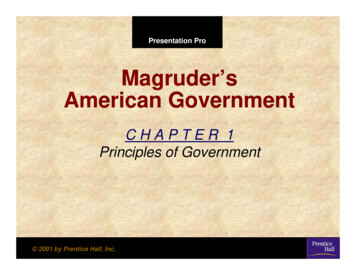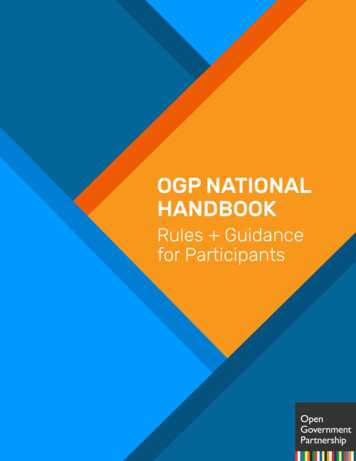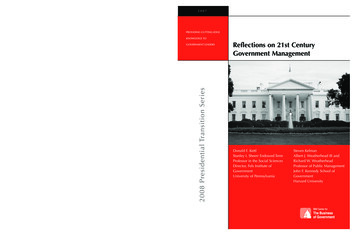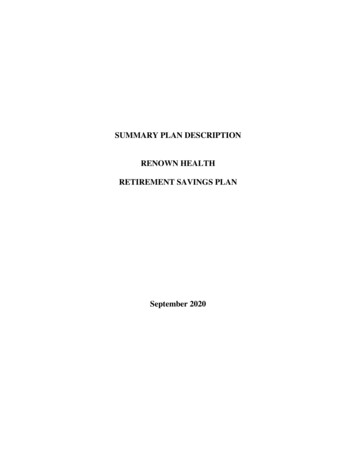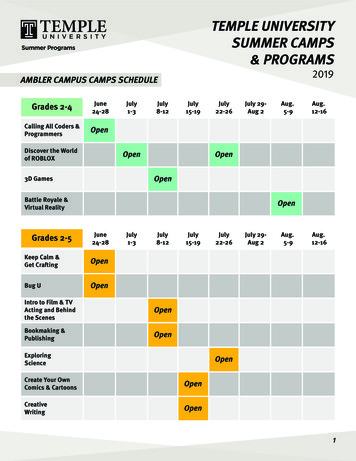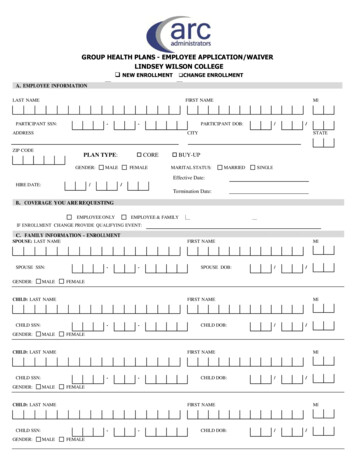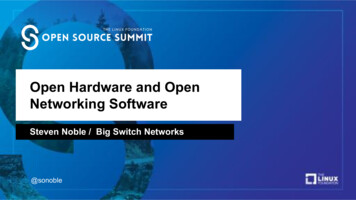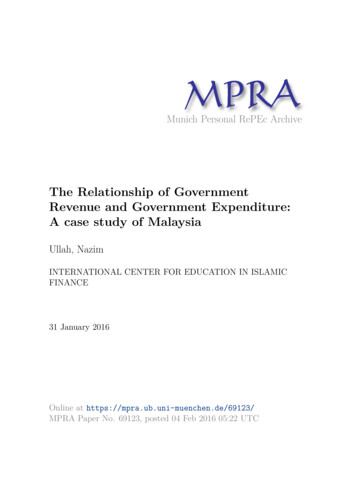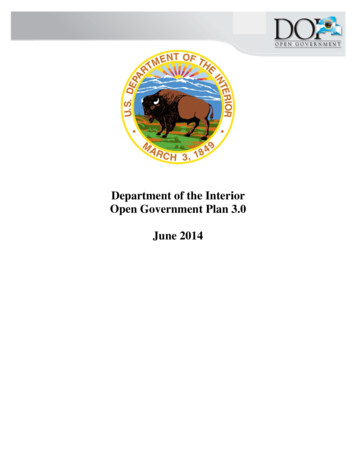
Transcription
Depaartmennt of thee InteriiorOpenn Governmentt Plan 3.0Junne 20144
2I am pleased to present Version 3.0 of the Department of the Interior's Open Government Plan.The Department is dedicated to using sound science to manage and sustain America's lands,water, wildlife, and energy resources, honor our Nation's responsibilities to tribal nations, andadvocate for America's island communities. As keepers of our Nation's legacy, we manage theresources in our care to benefit Americans now and in the future. Our Department and itsemployees are developing and implementing the cutting-edge science and expert managementtechniques that make this possible.The Department is committed to engaging stakeholders and the public to better carry out itsmission. Through initiatives like America's Great Outdoors, the Department is working to makethe Federal Government a better partner with states, tribes, and local communities. TheDepartment believes lasting conservation solutions should come from the American people andis excited to support the Open Government Initiative as a means to better engage with the publicand set the course for America's conservation and recreation agenda in the 21st Century.The Department's missions require us to engage with the American public and our stakeholdersfor the health of our economy and our Nation's public lands, and it is critical that we work nowto establish meaningful and deep connections between young people - from every backgroundand every community - and America's great outdoors. These younger generations embody theprinciples of openness, transparency, collaboration, and participation and they will serve as thenext generation of the Department's employees and partners. The Department has set forth on anambitious initiative to inspire millions of these young people to play, learn, serve, and workoutdoors so that they will one day help lead the way in facing the challenges of climate change,water challenges, our new energy frontier, and meeting our solemn responsibility to federallyrecognized American Indian and Alaska Native tribes.We look forward to implementing the specific initiatives within this plan and engaging the nextgeneration of Americans to take the actions necessary to help America transform the challengesit faces today into opportunities for tomorrow.Sincerely,Sally Jew
3Table of ContentsI.II.III.IV.IntroductionFormulation of the PlanNew and Expanded Initiatives – Department of the Interior’s Open GovernmentInitiativesA. Collaboration ClinicsB. Open DataC. Proactive DisclosuresD. PrivacyE. Whistleblower ProtectionF. WebsitesOngoing InitiativesA. Participation in Transparency Initiativesi. Extractive Industries Transparency Initiativeii. Data.goviii. eRulemakingiv. IT Dashboardv. Recovery.govvi. Grants.govvii. CFDA.govviii. SAM.govix. FSRS.govx. USAspending.govB. Public NoticeC. Records ManagementD. Freedom of Information Act RequestsE. Congressional RequestsF. DeclassificationG. ParticipationH. CollaborationI. Flagship Initiativesi. Extractive Industries Transparency Initiativeii. MyAmericaJ. Public and Agency Ideas
4I.IntroductionThe Department of the Interior’s (Department) broad mission spans the Nation, from the Arcticin Alaska to the southern tip of Florida, and from Midway Island in the Pacific Ocean to theVirgin Islands in the Caribbean. We manage 500 million acres of lands primarily located in theWestern States and 1.7 billion acres on the Outer Continental Shelf. The activities of theDepartment are an economic engine. In 2012, the Department’s programs contributed anestimated 371 billion to the U.S. economy and supported 2.3 million jobs in activities includingoutdoor recreation and tourism, energy development, grazing and timber harvesting.The Department’s programs contribute to the quality of life for many people and communitiesacross the Country and help to advance goals for stewardship and energy independence. Nearlyevery American lives within an hour’s drive of lands or waters managed by the Department. In2012, there were 417 million visits to departmentally managed lands. Recreational visits to theDepartment’s lands had an economic benefit to local communities, particularly in rural areas,contributing an estimated 45 billion in economic activity in 2012. The Department oversees theresponsible development of 23 percent of U.S. energy supplies, is the largest supplier andmanager of water in the 17 Western States, maintains relationships with 566 federally recognizedtribes, and provides services to more than 1.7 million American Indian and Alaska Nativepeoples.The context for this Open Government Plan reflects the complex mission of the Department andhow it affects the lives of all Americans. The Department’s 70,000 employees work inpartnership with other Federal agencies, states, tribes, industry, and a rich diversity ofstakeholders to preserve and interpret the Nation’s rich heritage and history; manage diverseFederal lands, waters, and wildlife and fishery resources; provide world-class science thatprotects us from hazards and provides the public with critical information on the earth, energy,water, and resource conservation; ensure the conservation and delivery of water for diverseusers; and deliver a suite of programs for American Indian and Insular communities. This OpenGovernment Plan therefore reflects that for the Department, the principles of openness,transparency, collaboration and public participation are not a set of ideals, but a criticalcomponent of how we carry out our mission and true reflection on the nature of the Department.II.Formulation of the PlanThe Department’s Open Government Version 1.0 plan focused on the establishment offoundational transparency and openness efforts and standards within the Department, such as thepublication of high value datasets to Data.gov, development of common data standards wherepossible, and building the structures and policies necessary to support further Open Governmentefforts. Plan 1.0 involved each of the Department’s bureaus in its development and was led bythe Office of the Chief Information Officer. As we implemented the initiatives of version 1.0,we discovered opportunities to further instill the values of Open Government within theDepartment, thereby impacting the very way in which the Department carries out its mission.Our early successes related to initiatives identified in Version 1.0 of our plan created newopportunities exponentially throughout the Department. To seize these opportunities, we
5recognized the need for additional partners within the Department and additional knowledgeleadership in areas such as culture change design.Version 2.0 of the Department’s Open Government Plan sought to highlight the success ofimplementing the initiatives of Version 1.0 of the Department’s plan and to build upon thosefoundational efforts. A major portion of the Department’s efforts in Version 2.0 of the plan wereto refine and build upon the success of prior initiatives and move from initiatives such aspublication of data to utilizing this published data to support openness, transparency,collaboration, and public participation. Version 2.0 of the plan also reflected the Department’slead role in the Extractive Industries Transparency Initiative (EITI). The EITI was identified inthe first National Action Plan as a major transparency and collaboration initiative for the Nationand the Department was tasked with the implementation of this initiative.Version 3.0 of the Department’s Open Government Plan furthers the efforts to implement theprinciples of openness, transparency, collaboration, and participation within the workings of theDepartment in order to better carry out our missions and serve the American public. In addition,the Department has engaged stakeholders, such as the International Association for PublicParticipations, the Union of Concerned Scientists, the Government Accountability Project, andthe Center for Effective Government to assist in the development of specific initiatives withinthis plan. While this plan identifies specific initiatives for the Department, it is our hope that itspublication will set the stage for further discussion and engagement with stakeholders and thepublic to develop and refine the Department’s efforts to meet the requirements and the spirit setforth by the Open Government Initiative.III.New and Expanded InitiativesA. Collaboration ClinicsThe Department is piloting Collaboration Clinics to help Departmental staff and leadershipdevelop specialized skills needed to work more collaboratively with external partners andstakeholders in order to support more effective planning, decisionmaking, resourcemanagement, and landscape level conservation. The National Park Service (NPS) and theOffice of Collaborative Action and Dispute Resolutions (CADR) have collaborativelydeveloped a 2-3 day workshop where collaborative problem solving is explained anddemystified and the three main stages of collaborative problem solving are demonstrated.Utilizing a planning, doing, and implementation framework, these Collaboration Clinicssupport the efforts of the Department’s on-the-ground personnel where engagement andcollaboration with the public and stakeholders is crucial in their ability to carry out theDepartment’s missions. These Collaboration Clinics are also designed to include facilitateddiscussions around group dynamics which may come into play as well as development ofthe individual skills needed to be most effective. The program is currently being piloted atNPS sites and these clinics are designed to increase the Department’s in-house collaborativecapacity while focusing on a site’s particular needs or situation. The site is left with greaterunderstanding, skills, and an action plan for tackling either a controversial issue or acomplex collaborative process with stakeholders. Utilizing a train-the-trainer model, the
6Department is gearing up to hold 10-12 clinics per year at various sites. Clinics are beingheld at the invitation of NPS parks and other units.B. Open DataGovernment open data is a valuable national resource, and the Department is deeplycommitted to open data as a cornerstone component of enabling transparency, engagingcitizens, and driving innovation. The Department’s Open Data strategy is aligned with theExecutive Order “Making Open and Machine Readable the New Default for GovernmentInformation” that President Obama issued on May 9, 2013, and the associated OMBMemorandum (M-13-13), which together will fundamentally transform the way in whichthe Federal Government manages data.In order to make our data assets more open and available, the Department has been buildinga Department-wide Data Services Team, setting up basic data management processes andinfrastructure (such as the Department’s Enterprise Data Inventory in our EnterpriseMetadata Repository, and continually improving our public-facing “data hub”), andcollaborating with the Department’s program leads and mission staff. During this earlystage of our efforts, we have discovered and documented thousands of new datasets, and areworking to improve and standardize the quality and stewardship of these and our largevolume of datasets already available in open formats. Bureaus and offices have beencollaborating very closely, working together, and helping each other. The Open DataInitiative bridges our mission areas, data management, and IT programs; together we areworking to discover and deliver the true value of open data.The Department’s Open Data approach is to follow data lifecycle management processes,manage our data as a strategic asset, deliver data and data products as services, and sharedata and information to promote innovation and increase Government transparency.The Department’s data and data products span a wide range of programs and activities, andrepresent areas of continuing interest for our stakeholders and the public. As one of thelargest contributors of metadata records to Data.gov and as the Managing Partner forFederal Geospatial Shared Services, the Department has been publishing data in support ofthe Open Government Initiative and Federal Shared Services for many years. Building ourprograms around Open Data principles will allow the Department to advance itsmanagement of data as strategic assets and to deliver improved data services to the public aswell as to our own bureaus and offices. The internal use of Open Data is critical to theongoing success of our activities in this arena. It is clear that Departmental policydevelopment and service delivery will benefit from the effective and judicious use of OpenData. Inside the Department, Open Data can be used to streamline service delivery, createopportunities for innovation, identify new service and policy approaches, and generally,support the effective delivery of existing programs across a broad range of the Department’soperations.
7The Department of the Interior’s Open Data Goals include: Manage all data assets used in the Department, bureau and office programs, missionrelated data collection efforts, processes, and information systems. This includes dataassets produced through DOI contracts and cooperative agreements, and in somecases Department-funded grants. It also includes data assets associated with, but notlimited to, research, program administration, statistical, and financial activities. Separate data from systems and applications so that data can be managed, shared andreused as appropriate Follow data lifecycle management practices through strengthening the datamanagement frameworks and processes among bureaus and offices across theDepartment. Deliver data and data products as services, from building a DOI Enterprise DataInventory towards considering the development of a future Department DataMarketplace. Develop a robust consumer feedback process that aligns the Department’s dataservices with user needs, promotes internal and external innovation, and effectivelyengages the user community.Transparency Governance and Culture ChangeIn support of the Open Data Policy, the Department of the Interior’s CIO issued aMemorandum defining the Departmental strategy for implementing the Policy. It calls forone mission program lead and one data lead per bureau and office to serve on aDepartmental Data Governance Board to support and govern the Open Data Initiative at theDepartment. Open Data is an effort that requires both mission and information technologystaff to join together to deliver results. Managing data effectively and sharing datainternally and externally is a foundation for many of the Department’s initiatives and a keyelement to enabling improved and efficient mission delivery.The Memorandum established a Data Service Team charged with the management of dataand delivery of services. The team is comprised of a mix of people from management andprogram operations to technical and IT staff, and from local data managers to seniorexecutives. Each member brings his or her expertise in program subject matter, policy, andinformation technology or data management. Together, this team will serve as the bridgebetween the Department’s mission areas and data management components, and the bridgebetween bureaus and offices of differing levels of data management expertise. This teamwill deliver the value of Open Data to the Department’s internal operations and the public.The Data Service Team will collaboratively align data management efforts at each bureauand office, and share knowledge, processes and tools to synchronize transformation of dataassets into data services.Open Data Phased ApproachThe Department is addressing its open data strategy and planning through a four-phaseapproach. Many of the goals in the ‘Foundation’ phase are past their initial implementationand are now being iterated and improved upon. The Department’s Data Service Team iscurrently focusing on many of the goals in the ‘Structure’ phase.
8Efforts the Department has accomplished as a foundation include: Issued the Department’s Open Data Memo supporting M-13-13 in September 2013 Formed the Department’s Data Governance Board with both a program lead and datalead per bureau/office, and the Department’s Data Service Team with openmembership across the Department Built the Department’s Enterprise Data Metadata Repository which hosts theDepartment’s Enterprise Data Inventory (EDI) and publishes our Public Data Listing(PDL) via open source technology (CKAN). This inventory allows users to find anddownload public datasets, either in bulk or through APIs (where available andappropriate) Developed strategy for alignment of the metadata standards of ISO (ISO-19115:2003,Geographic Information), Data.gov and Project Open Data to register metadata of theDepartment’s datasets Collection of metadata through automatic harvesting and simple entry via web formsquarterly at minimum Delivery of the Department’s Data.JSON to OMB MAX as per M-13-13 requirement Publication of the Department’s Public Data List at www.doi.gov/data.json Established consumer feedback mechanism (issue tracker)Additionally, the Department is currently building the structure to further support theseOpen Data efforts by: Developing the Department’s Data Resource Management Departmental Manual Developing the Department’s Data Governance Board Charter Developing the Department’s Metadata Policy and its Implementation Guidance Developing the Department’s Open Data Policy and Implementation Guide Developing the Department’s Open Data Communication Plan Developing the Department’s Data Hub (external) and the Department’s Data ServiceSite (internal) for communication and feedback.o The Hub pulls the Department’s information on available data and developerresources into one, user-focused site.o The Service Site provides a place for the Department’s colleagues to sharebest practices and data management resources Delivered data management training for the Department’s Data Service Team andprogram managers (four-day workshop and training happened in Denver, Spring2014) Continue enhancing the Department’s Enterprise Data Inventory, the Department’sPublic Data Listing, and APIs/web servicesThe Department has also identified and is working to implement the following next steps formanaging data as an asset and building communities: Develop the Department’s Data Release Process Develop a method for discovering unidentified datasets and linking existing datasetsto new uses in a methodical way to support mission goals
9 Develop a method to increase the value of prioritized datasets by packaging and/ormanaging them as servicesProvide basic analytics using the Department’s data for support of internal decisionmakingEstablish regular information sharing sessions on open data and data service deliverytopicsContinue enhancing the Department’s Enterprise Data Inventory, the Department’sPublic Data Listing, and APIs/web servicesBased on user feedback, provide data and data products as packaged services viadoi.gov/dataPlan a data jam or hackathon at the DepartmentConsumer Feedback and Data Publishing ProcessThe Department has established a public, transparent online feedback tracking site athttp://usinterior.ideascale.com/ to encourage public collaboration and participation. Thisplatform provides the ability to publically track issues and suggestions about data access atthe Department. It also provides the ability for the public or members of the governmentcommunity to “push up” popular suggestions by “agreeing” or “disagreeing,” therebyranking ideas or issues. Responses are also catalogued, providing accountability for actions.The Ideascale system is also being incorporated in the Department’s Data Hub so that userswill not need to go to a separate site to provide feedback, but will have all of theDepartment’s data-related resources in one place.The Data Services Team will regularly review feedback on this site and address issues asappropriate. In some cases, this might mean a response that explains timelines for datarelease, or explains why a dataset cannot be released. In other cases, actions will be taken toaddress the issues raised.This consumer feedback will be taken into account in the Department’s data publishingprocess and will help in guiding the Department’s data resource priorities to those dataassets of most value to the public. In addition, once the Department’s data publicationinfrastructure is ready (i.e., when CKAN and its linkages to Data.gov are fully functional,and the Department’s employees have a sustainable process for data maintenance andstewardship), bureaus and offices will be free to publish new and/or improved public dataand information as soon as it is available. This process of publication and feedback willmove the Department to a healthy data management lifecycle state.Current StatusThe Department is systematically inventorying data assets, including those that are public,non-public, and restricted. The Department has added thousands of datasets to its EnterpriseData Inventory since the publication of M-13-13. In addition, the Department will continueto Enhance its Enterprise Data Inventory.
10The Department is making public data assets available for discovery, download and usethrough the Department’s Data Catalog. The Department’s Public Data Listing is alsoavailable as a JSON file at www.doi.gov/data.json.The Department has encouraged public use of already released datasets by continuouslyimproving its data access and datasets through response to public feedback. For example,the Department recently supported the release of some key datasets, which are a part of theClimate Data Initiative in a new format (JSON) at the request of external organizations. TheDepartment is also continuously improving its data— Data Hub – to make it more usable,and provide more resources for the public (both specialists and general users).The Department is also working to implement a systematic data management framework toensure data quality and stewardship over the long term. This framework will allow thecontinual discovery of existing data that will be cataloged and made discoverable, asappropriate. Completion of the “Foundation” and “Structure” phases mentioned above willresult in the Department’s mission programs’ ability to register and publish datasets as soonas they are ready to be made available.Part of the Department’s Open Data Initiative, the data management plan, will enable theDepartment to manage data as assets which will in turn increase the Department’saccountability, transparency, and responsiveness; improve public knowledge about theDepartment’s bureaus and offices; further the Department’s core mission; and create furthereconomic opportunities for the Nation.C. Proactive DisclosuresThe Department’s efforts to proactively disclose information to advance transparency,accountability, and openness can be seen throughout various sections of this Plan, such asbut not limited to FOIA, Records Management, and Open Data.D. PrivacyThe Department is committed to the principles of transparency and openness while alsomeeting its responsibilities to privacy compliance. The following list includes variousprivacy compliance reports applicable to the Department and is also available on theDepartment’s Privacy Program website athttp://www.doi.gov/ocio/information assurance/privacy/privacy-reports.cfm.Annual FISMA SAOP ReportThe Department submits a Senior Agency Official for Privacy (SAOP) report annually tothe Office of Management and Budget (OMB) and Department of Homeland Securitythrough CyberScope in accordance with the Federal Information Security Management Actof 2002 and OMB policy. The SAOP report documents findings from privacy programreviews and compliance activities. The OMB annual reports to Congress on Federal agencyimplementation of the Federal Information Security Management Act of 2002 are available
11to members of the general public on the OMB Office of E-Government & InformationTechnology website at http://www.whitehouse.gov/omb/e-gov/docs/.Annual Report to Congress on the Implementation of the E-Government Act of 2002The Department submits a report annually to OMB for the Annual Report to Congress onthe Implementation of the E-Government Act of 2002. This annual report includes a sectionon Privacy Policy, Privacy Impact Assessments, Privacy Training, and descriptions ofagency compliance with the privacy provisions of the E-Government Act of 2002. TheAnnual Report to Congress on the Implementation of the E-Government Act of 2002 isavailable to members of the general public on the OMB Office of E-Government &Information Technology website at http://www.whitehouse.gov/omb/e-gov/docs/. TheDepartment’s annual submissions to OMB for the Annual Report to Congress on theImplementation of the E-Government Act of 2002 may be viewed by general members ofthe public on the Department’s website at http://www.doi.gov/ocio/egov/index.cfm.ISE Annual Report to the CongressThe Department submits a report annually to the Program Manager for the InformationSharing Environment (ISE) for the ISE Annual Report to the Congress in accordance withthe Intelligence Reform and Terrorism Prevention Act of 2004. This annual report includesa section dedicated to protecting privacy, civil liberties, and civil rights and meetingcompliance requirements and Administration performance goals for information sharing andsafeguarding. The ISE Annual Report to the Congress is available to members of thegeneral public on the ISE website at http://www.ise.gov/annual-report.E. Whistleblower ProtectionThe Department understands the vital role its employees play when they disclose a violationof law, rule, or regulation, gross mismanagement, gross waste of funds, an abuse ofauthority, and a substantial and specific danger to public health and safety. Protecting andsupporting these individuals is crucial to ensuring that employees will continue to best servethe American public by drawing attention to any misuse of the public trust. Whistleblowerprotection laws exist to protect employees who fear or suffer reprisal for making adisclosure. The Whistleblower Protection Enhancement Act of 2012 paves a smoother pathfor whistleblowers and yet, in reality, challenges will still exist. The Department and theOffice of the Inspector General (OIG) are committed to meeting those challenges, within itsstatutory authority, through an informed and equipped constituency and will work tirelesslyto influence the Department’s to sustain a culture that values whistleblowers and opposesretaliation.The OIG Whistleblower Protection and Ombudsman Program (WBPOP) ensures thatemployees who disclose information are fully informed of their rights, responsibilities, andremedies under anti-retaliation laws, and provides advisory services and support towhistleblowers which may include a formal OIG investigation. The Department iscommitted to training officials and managers on best practices to ensure whistleblowers are
12not retaliated against. Additionally, the Department is committed to meetingsresponsibilities for compliance with the Office of Special Counsel's 2302(c) CertificationProgram.F. WebsitesThe Department is committed to developing a culture that serves the public by providinginformation in a useful and accessible format through traditional websites as well asincreasingly through various social media outlets. To support these efforts, the Departmentdeveloped a Digital Strategy to engage the public and share information the public andstakeholders may find useful. This strategy, www.doi.gov/digitalstrategy/index.cfm, supportsthe Department’s efforts to be more open and transparent and has contributed to theDepartment’s Media and Social Media policies receiving high marks from the Union ofConcerned Scientists, going InitiativesA. Participation in Transparency Initiativesi. Extractive Industries Transparency InitiativeIn the United States’ first National Action Plan, President Obama announced the UnitedStates’ commitment to implementing the EITI, a voluntary, global effort designed toincrease transparency, strengthen the accountability of natural resource revenuereporting, and build public trust for the governance of revenues received for oil, gas,and mineral extraction. Recognizing the Department’s lead role in the management ofrevenues associated with Federal offshore and Federal and American Indian onshoremineral leases, as well as revenues received as a result of offshore renewable energyefforts, President Obama named the Secretary of the Interior as the Administration’sSenior Official responsible for the oversight of implementation of EITI.On December 11, 2013, the USEITI Multi-Stakeholder Group approved the U.S.Candidacy Application for Secretary Jewell’s transmission to the International EITIBoard and on December 19, 2013, Secretary of the Interior Sally Jewell submitted theApplication to the EITI International Board.Through the efforts of the USEITI Multi-Stakeholder Group, the U.S. application forcandidacy in the Extractive Industries Transparency Initiative was approved by theEITI Board at its March 18-19 meeting in Oslo, Norway. The U.S. is the first G8country to achieve candidate status and become an EITI implementing country, joininga group of 41 countries around the world that are working actively to improve themanagement of their oil, gas, and mining sectors.With approval of its candidacy application, the U.S. is now moving towardsproductions of its first USEITI Report within the next 2 years and completion of the
13remaining requirements to become an EITI Compliant Country. For more information,please see the Flagship Initiatives section of this Plan.ii. Data.govIn addition to its own Open Data Initiative, the Department continues to support thepublication o
to refine and build upon the success of prior initiatives and move from initiatives such as publication of data to utilizing this published data to support openness, transparency, collaboration, and public participation. Version 2.0 of the plan also reflected the Department's lead role in the Extractive Industries Transparency Initiative (EITI).
